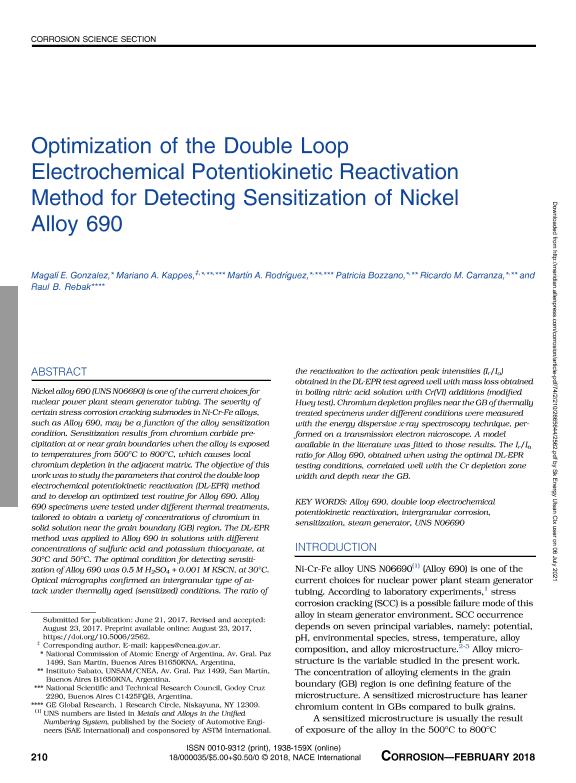Mostrar el registro sencillo del ítem
dc.contributor.author
Gonzalez, Magalí Estefanía

dc.contributor.author
Kappes, Mariano Alberto

dc.contributor.author
Rodríguez, Martín Alejandro

dc.contributor.author
Bozzano, Patricia Beatriz

dc.contributor.author
Carranza, Ricardo Mario

dc.contributor.author
Rebak, Raul Basilio

dc.date.available
2021-07-14T18:36:14Z
dc.date.issued
2018-02
dc.identifier.citation
Gonzalez, Magalí Estefanía; Kappes, Mariano Alberto; Rodríguez, Martín Alejandro; Bozzano, Patricia Beatriz; Carranza, Ricardo Mario; et al.; Optimization of the double loop electrochemical potentiokinetic reactivation method for detecting sensitization of nickel alloy 690; NACE International; Corrosion; 74; 2; 2-2018; 210-224
dc.identifier.issn
0010-9312
dc.identifier.uri
http://hdl.handle.net/11336/136142
dc.description.abstract
Nickel alloy 690 (UNS N06690) is one of the current choices for nuclear power plant steam generator tubing. The severity of certain stress corrosion cracking submodes in Ni-Cr-Fe alloys, such as Alloy 690, may be a function of the alloy sensitization condition. Sensitization results from chromium carbide precipitation at or near grain boundaries when the alloy is exposed to temperatures from 500°C to 800°C, which causes local chromium depletion in the adjacent matrix. The objective of this work was to study the parameters that control the double loop electrochemical potentiokinetic reactivation (DL-EPR) method and to develop an optimized test routine for Alloy 690. Alloy 690 specimens were tested under different thermal treatments, tailored to obtain a variety of concentrations of chromium in solid solution near the grain boundary (GB) region. The DL-EPR method was applied to Alloy 690 in solutions with different concentrations of sulfuric acid and potassium thiocyanate, at 30°C and 50°C. The optimal condition for detecting sensitization of Alloy 690 was 0.5 M H2SO4 + 0.001 M KSCN, at 30°C. Optical micrographs confirmed an intergranular type of attack under thermally aged (sensitized) conditions. The ratio of the reactivation to the activation peak intensities (Ir/Ia) obtained in the DL-EPR test agreed well with mass loss obtained in boiling nitric acid solution with Cr(VI) additions (modified Huey test). Chromium depletion profiles near the GB of thermally treated specimens under different conditions were measured with the energy dispersive x-ray spectroscopy technique, performed on a transmission electron microscope. A model available in the literature was fitted to those results. The Ir/Ia ratio for Alloy 690, obtained when using the optimal DL-EPR testing conditions, correlated well with the Cr depletion zone width and depth near the GB.
dc.format
application/pdf
dc.language.iso
eng
dc.publisher
NACE International

dc.rights
info:eu-repo/semantics/openAccess
dc.rights.uri
https://creativecommons.org/licenses/by-nc-sa/2.5/ar/
dc.subject
ALLOY 690
dc.subject
DOUBLE LOOP ELECTROCHEMICAL POTENTIOKINETIC REACTIVATION
dc.subject
INTERGRANULAR CORROSION
dc.subject
SENSITIZATION
dc.subject
STEAM GENERATOR
dc.subject
UNS N06690
dc.subject.classification
Otras Ingeniería de los Materiales

dc.subject.classification
Ingeniería de los Materiales

dc.subject.classification
INGENIERÍAS Y TECNOLOGÍAS

dc.title
Optimization of the double loop electrochemical potentiokinetic reactivation method for detecting sensitization of nickel alloy 690
dc.type
info:eu-repo/semantics/article
dc.type
info:ar-repo/semantics/artículo
dc.type
info:eu-repo/semantics/publishedVersion
dc.date.updated
2021-07-05T14:35:24Z
dc.journal.volume
74
dc.journal.number
2
dc.journal.pagination
210-224
dc.journal.pais
Estados Unidos

dc.journal.ciudad
Houston
dc.description.fil
Fil: Gonzalez, Magalí Estefanía. Comisión Nacional de Energía Atómica. Gerencia de Área de Energía Nuclear. Gerencia Materiales; Argentina. Universidad Nacional de San Martín. Instituto Sabato; Argentina
dc.description.fil
Fil: Kappes, Mariano Alberto. Consejo Nacional de Investigaciones Científicas y Técnicas; Argentina. Comisión Nacional de Energía Atómica. Gerencia de Área de Energía Nuclear. Gerencia Materiales; Argentina. Universidad Nacional de San Martín. Instituto Sabato; Argentina
dc.description.fil
Fil: Rodríguez, Martín Alejandro. Consejo Nacional de Investigaciones Científicas y Técnicas; Argentina. Comisión Nacional de Energía Atómica. Gerencia de Área de Energía Nuclear. Gerencia Materiales; Argentina. Universidad Nacional de San Martín. Instituto Sabato; Argentina
dc.description.fil
Fil: Bozzano, Patricia Beatriz. Comisión Nacional de Energía Atómica. Gerencia de Área de Energía Nuclear. Gerencia Materiales; Argentina. Universidad Nacional de San Martín. Instituto Sabato; Argentina
dc.description.fil
Fil: Carranza, Ricardo Mario. Comisión Nacional de Energía Atómica. Gerencia de Área de Energía Nuclear. Gerencia Materiales; Argentina. Universidad Nacional de San Martín. Instituto Sabato; Argentina
dc.description.fil
Fil: Rebak, Raul Basilio. General Electric Global Research; Estados Unidos
dc.journal.title
Corrosion

dc.relation.alternativeid
info:eu-repo/semantics/altIdentifier/url/http://corrosionjournal.org/doi/10.5006/2562
dc.relation.alternativeid
info:eu-repo/semantics/altIdentifier/doi/https://doi.org/10.5006/2562
Archivos asociados
